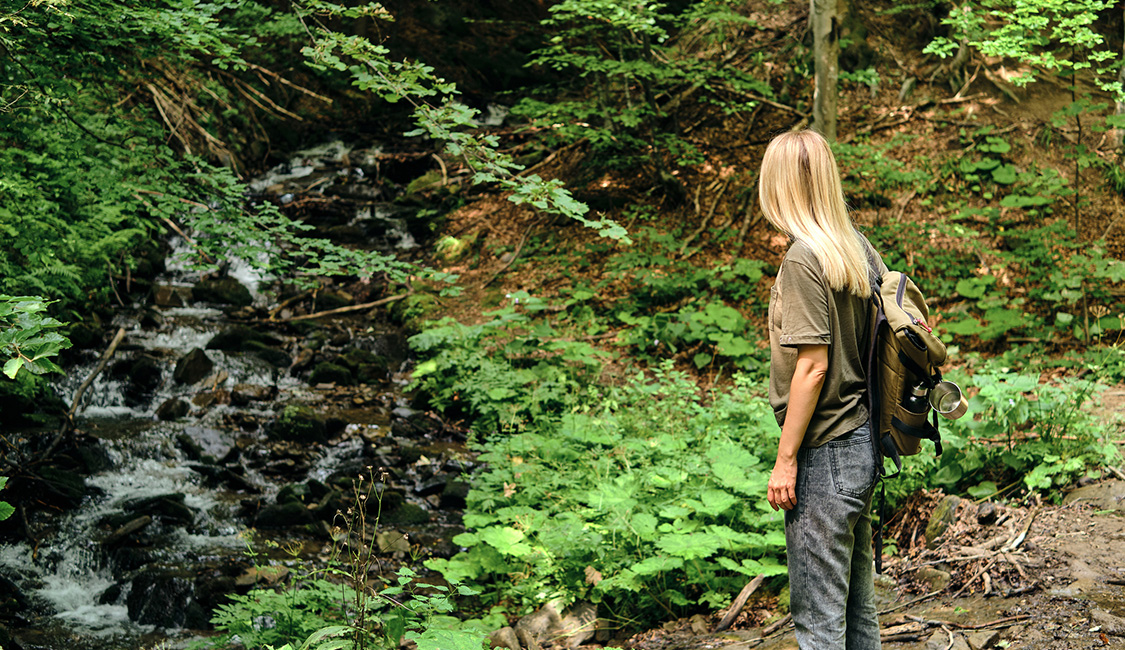How to Design Well-Being Spaces in a Stressful World
July 20, 2022
Interview with interior designer Stephanie Parisi reveals her insights and design principles for creating wellness spaces by bridging the worlds of nature, art and science.
With everyone from Gwyneth Paltrow to Oprah to Johns Hopkins University singing the praises of wellness, it’s no wonder that awareness of wellness is taking hold in our culture. Wellness has become a bit of a buzzword lately. But what does it really mean?
According to the World Health Organization, wellness goes beyond a state of absence of illness to states of emotional/physical and social well-being. Thriving is another word used to describe this state. So, it is more than being healthy. It is about feeling good in a holistic way.
And research has shown that our environments have a big impact on this sense of well-being. Environments have the capacity to support and embrace us in many ways allowing us to function at higher levels by reducing stress, uplifting mood, recover more quickly from injury, and in a stressful world, provide physical, emotional and spiritual comfort.
Sounds like a big promise? Well, let’s take a deeper look to see how we might unlock some formulas to create spaces which allow us to flourish in a stressful world….
Q. What interested you about the “Well-Being” space in the field of design?
Stephanie: I had an interest from an early age and actually studied art, psychology and environment in college. As a designer, I have always noticed the emotional component of design. We experience spaces based on a variety of their attributes…size, ceiling height, configuration, proximity to light sources, the components within the space, color, textures, etc. As I develop an interior, I imagine variations of design for the spaces, and that involves, among other things, tracking the emotions one might feel experiencing the space. I’ve always done this in an intuitive way. I get feedback from clients such as “I feel so calm in this space” or “What an uplifting feeling I have in here” … so beyond the practice and aesthetic aspects of the design, there has always been the pleasing aspect of how, as designers we can really impact the emotions of people who occupy the spaces.
I was curious to see if there was current science to back up my intuitive approach. My primary interest was to explore ways I could expand my own awareness as a designer by not only creating beautiful spaces, but by deliberately including elements to support physical and emotional well-being.
Q. Was there a pivotal point in your career which inspired you to look further into this type of research?
Stephanie: A while ago, I took a short sabbatical and moved to my ranch which is surrounded by national forest. In this total immersion environment, surrounded by horses, creeks, trees and mountains, I felt my body and psyche totally relax. I felt a wonderful harmony in which my creativity and health flourished.

In eventually returning to my home close to the Southern California coast, I was once again immersed in urban life… overwhelmed with its traffic, noise, electronics, etc. I have since discovered that this experience actually has a named called “Information Overload” which aptly describes how I was feeling!
So, this was a pivotal point for me. My curiosity was piqued in a personal way and I started to explore. The question I was hoping to answer was, “Is there a formula we, as designers, could learn in order to capture the harmonious feeling I experienced at my ranch and allow us to bring it into our modern environments?”
The notion of incorporating science backed design elements into our spaces to impact the physical, mental, emotional and spiritual parts of ourselves opened up a new chapter in my design journey.
Q. In your review of the science, can you tell us some of the highlights?
Stephanie: Well, first, I have to say I was amazed at the vast number of research studies that were available to review. Because of its name, “Forest Bathing” caught my attention. Forest Bathing, or Shinru-Yoku, is a Japanese practice that involves spending time in nature. Because of my own experiences exploring forests in various parts of the world, including Japan, I found the findings about this practice fascinating.

Japanese scientists have studied this experience intensely and discovered it to have such powerful effects that Japanese insurance companies actually cover the costs associated with the practice. Some of the benefits of this practice which involves taking in the sights and sounds of the forest, including biological improvements such as reduced blood pressure, accelerated healing from surgery and illness, improved immune system function, etc.
See my article on “The Healing Way of Nature”
Apparently, on average, Americans spend 87% of their time indoors and 6% of their time in closed vehicles…many experts believe that the stress from lack of time outdoors and away from technology contributing to many types of chronic illnesses.
The discoveries made about nature immersion in the Forest Bathing experience holds some powerful remedies which may be part of our formula for designing spaces for comfort in modern urban settings.
Another category of research in creating spaces which support various aspects of well-being is organized under the heading of neuroscience—neuroscience for architecture, neuroaesthetics, etc.—and is being conducted globally. Research institutes as esteemed as the Salk Institute and Johns Hopkins University are taking part in explorations of the intersection of design, architecture and science. Armed with technology such as brain scans, blood analysis and pulse rate read outs, scientists are taking a close look at how environments affect our emotions, ability to focus and learn, stress levels and feelings of general well-being.
See my article on “Are neuroscientists the New Architects?”
Designers have always known that the environment affects people. However, it is only recently that we have been able to quantify these effects with scientific data.
Although, as one scientist explained, “There is no such thing as a universal brain”, as responses to environments do vary based on culture, genetics, history, etc., however, there are certain “universals” being discovered which provide keys to designing supportive spaces for specific functions.
Q. How do these study results translate to design which supports states of well-being?
Stephanie: Ingredients such as color, shapes, tactile surfaces, novelty, perception of volume of space, scents and sounds can all be a part of the formula for building supportive spaces. Let’s take a look at a few “universals” which can be drawn from the design toolbox to create different types of biologically and emotionally supportive effects.
- Round lines and circles are more pleasing than angular shapes. They relax the brain and are comforting. Angular forms are thought to be sophisticated but elect an unconscious negative avoidance response. Note the relationship to shapes in nature.
- The shape of the room and objects within the room influence emotions based on familiarity, symmetry, contrast and complexity. Humans seem to be more comfortable in spaces that are what’s called “fluent”, meaning they can be easily read. And the more sophisticated the user of the space, in terms of exposure to design, the more complexity they enjoy.
- Moderately visually active environments can actually stimulate parts of the brain connected with memory. So when designing learning environments, spaces with moderate complexity in terms of color, novelty and visual challenge support memory and learning.
- Environments enriched with rounded shapes, natural elements, proper lighting for room function and scents in the room have been found to lead to brain cell growth.
- Volume of architectural space affects emotional response. High ceilings give a sense of freedom and independent thinking and lower ceilings can create a sense of calm, increases ability to focus and supports learning.
- Symmetry in architecture and objects is perceived to be calming and peaceful.
- Colors affect us at an unconscious level. Saturated colors amplify emotions and more muted are calming. Blues enhance productivity, are peaceful and encourage creative thoughts. Green brings people closer to nature and is soothing. Warmer bold colors elicit energy.
- Tactile materials increase connection to a space and support states of calm and tranquility. Consider door handles, contact with floors through walking, texture and temperature of surfaces. Soft, natural surfaces are pleasing.
- Natural features in a room such as plants, water, views to the outside are thought to give nourishment neurologically and improve focus, enhance memory, accelerate healing and recovery. Views of nature triggers parts of the brain associated with empathy and love.
- Water elements and even the sounds of water flowing trigger neurological responses of delight and serenity.
- Certain scents have been associated with positive responses. Lavender and other aroma therapies elicit better sleep and enhanced recovery from illness.
Q. What is the biggest take away for you that would interest readers?
Stephanie: The biggest take away for me was confirming that integrating nature into our designs has profound effects in creating calm and comforting spaces. And it is exciting to know that our bodies are so attuned to nature that we see measurable biological and neurological effects with design that stimulates nature. So mimicking elements of nature’s sensual shapes, sounds, textures and scents in our architecture and design allows us to bring into our fast-paced urban lives and environments the embracing comfort of the natural world. As more and more people turn their attention to wellness, we will see the growth of this type of research and its application in design.
| Stephanie Parisi Design Studio
Copyright © 2023